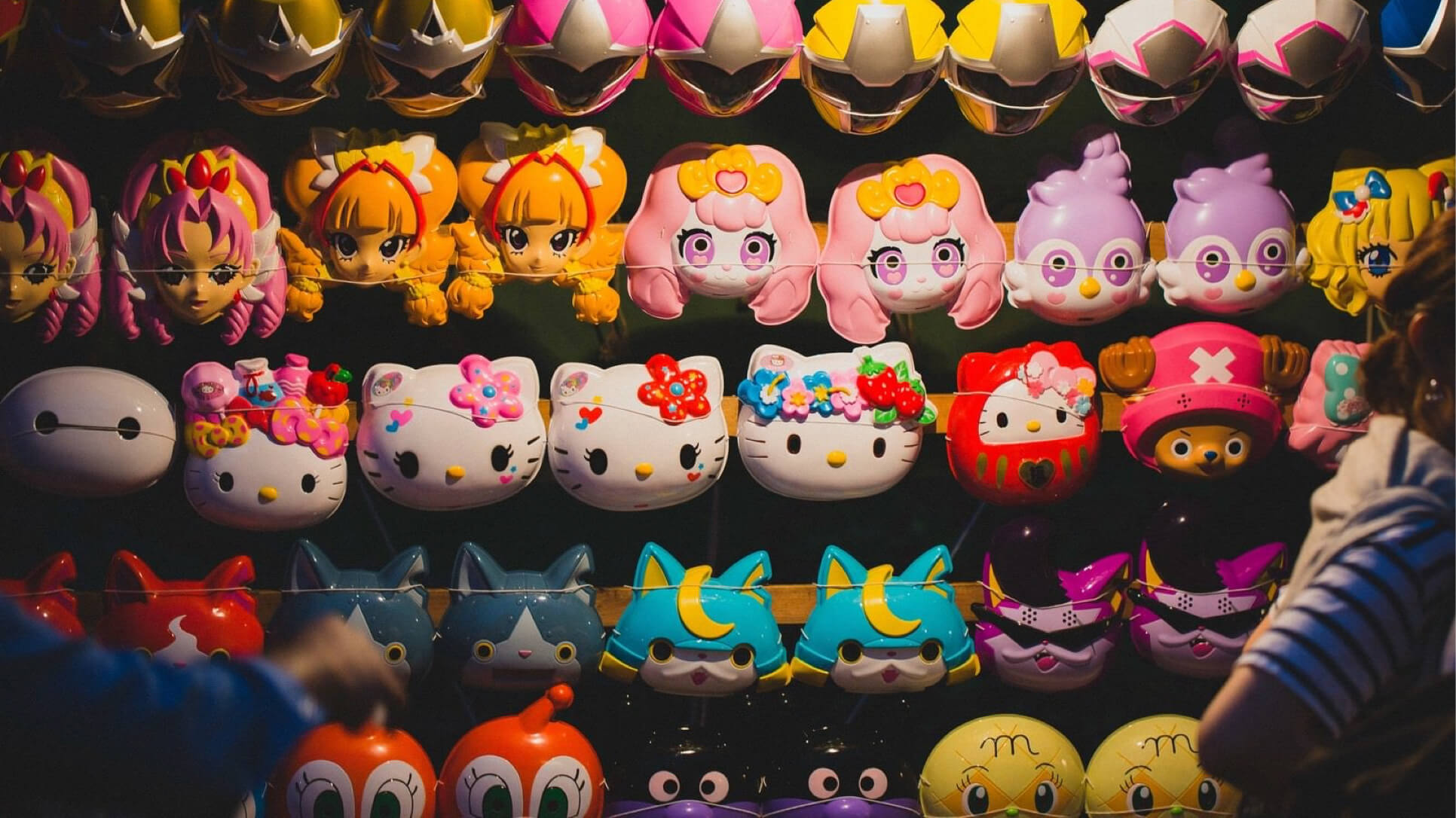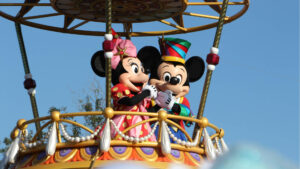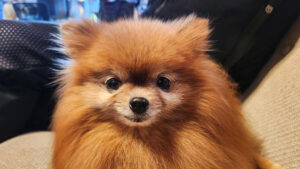Japanese character culture has extended far beyond the realms of anime and manga. It has become an integral part of daily life, a source of emotional comfort, and even a global phenomenon.
Rooted in the uniquely Japanese sensibility of “kawaii” (cuteness), these characters transcend age, gender, and borders—appearing on everything from stationery and electronics to regional revitalization campaigns and international cultural exchange programs.
In this article, we explore the charm and cultural background of Japan’s most iconic characters—from Sanrio and Pokémon to Studio Ghibli and local mascots—celebrated around the world.
Contents
- 1 Why Japanese Character Culture Is So Unique
- 2 The World of Sanrio: Hello Kitty and Friends
- 3 Pokémon: From Game to Global Phenomenon
- 4 Studio Ghibli: Unforgettable Characters That Stay in Our Hearts
- 5 The World of Regional Mascots (Yuru-Chara)
- 6 Japanese Character Culture: A Universal Language of Sensitivity and Imagination
Why Japanese Character Culture Is So Unique
Japanese character culture has developed in an exceptionally unique way, unlike anywhere else in the world. Behind its growth are the establishment of an aesthetic centered around “kawaii” (cuteness), a cultural tendency to naturally integrate characters into daily life, and a high level of creativity that enables diverse media expansion. Characters are not limited to anime and manga—they appear in public services, product packaging, transportation systems, and many other everyday settings.
This culture is not just commercially popular—it resonates with people’s emotions and memories, providing comfort and empathy through its characters.
The Concept of Kawaii Culture
“Kawaii” is a key concept in understanding Japanese character culture. It goes beyond physical cuteness to include qualities like innocence, fragility that evokes protection, and a humble demeanor.
In Japan, this “kawaii” sensibility is reflected in a wide range of characters and is embraced by people of all ages. Characters from Sanrio and animal figures from Studio Ghibli are rooted in this shared cultural value of cuteness.
Origins in Pop Culture
From the 1970s to the 1980s, “kawaii” rapidly spread through Japanese pop culture. Idol culture, girls’ manga, and Sanrio characters influenced one another and shaped what is now known as “kawaii culture.”
Hello Kitty, introduced during this era, became a global symbol of character culture from Japan. Her lack of a mouth allows fans to project any emotion onto her, making her a universally relatable figure.
Influence on Design
Japanese characters are often designed with large, expressive eyes and soft, rounded features that make them approachable. This style has extended beyond characters into fashion, electronics, and stationery—where “cute yet functional” items have become part of everyday life.
Subtle colors and intentionally simple designs also reflect Japan’s unique interpretation of kawaii.
Impact on Global Trends
The term “KAWAII” has become a globally recognized word, even in English-speaking countries. Japanese character culture is popular in places like Korea, Taiwan, the U.S., and France. Many products and brands have adopted kawaii elements into their designs.
Young people around the world share kawaii items on social media and enjoy cosplaying as their favorite characters. Japanese character culture has become a “universal language of emotion,” resonating across borders.
Characters Blended into Everyday Life
In Japan, characters are not seen as special or rare—they are naturally integrated into daily life. They appear not only on children’s items, but also on everyday goods for adults and even in public spaces. These characters add color to life and are cherished as sources of comfort and reassurance.
Beyond their cuteness and humor, characters also serve as conversation starters and contribute to enhancing the image of companies and local governments.
Stationery, Lunch Goods, Clothing, and More
Visit any stationery or variety goods store in Japan, and you’ll find shelves lined with character-themed products. Popular characters like Hello Kitty, Rilakkuma, and Sumikko Gurashi appear not only on notebooks, pencils, and pen cases, but also on lunch boxes, mugs, socks, and pajamas.
These goods are not only a source of fun for children, but also bring joy to adults, acting as small tools to brighten up everyday life by keeping their favorite characters close at hand.
Characters in Public Services
Character culture in Japan also extends to public institutions and local governments. Regional mascots and official characters appear at train stations, city halls, hospitals, and police stations to promote local charm and encourage communication with the public.
For example, JR West’s ICOCA mascot “Icoca-chan” and the police safety mascot “Pipo-kun” are widely recognized for their friendly appearances and roles in promoting public awareness.
Emotional Support Across All Ages
Characters are not just for children—they provide emotional comfort and relatability for adults as well. When feeling tired or stressed, just seeing a small character plush or item can bring a sense of peace to many people.
Characters like Sumikko Gurashi and Rilakkuma are especially beloved for their gentle messages, such as “It’s okay not to try too hard” and “You can just be yourself,” offering quiet support to modern hearts in need of kindness.

Sumikko Gurashi

Rilakkuma
The Fusion of Tradition and Modernity
Japanese character culture is not only about being “cute” or “fun”—it also reflects deep cultural roots and historical connections. Traditional elements and motifs are reimagined in modern ways and shared globally through media like anime and games.
Many characters draw from traditional Japanese aesthetics and folklore, infusing modern designs with a distinct sense of Japanese identity.
Designs Featuring Traditional Japanese Motifs
Motifs unique to Japan—such as cherry blossoms, Mount Fuji, origami cranes, goldfish, and bamboo—are frequently incorporated into character designs. For example, Sanrio characters like Cinnamoroll and My Melody have limited-edition versions dressed in kimonos or adorned with floral patterns, which are highly praised by overseas fans.
These designs evoke the beauty of Japan’s seasons, nature, and traditional events, making them popular as souvenirs and in international exhibitions.
Connections to Folktales and Mythology
Many Japanese characters are based on traditional folktales and myths. Characters from stories like “Momotaro” or “The Tale of the Bamboo Cutter” are often reimagined in modern games and anime.
Titles like “Yo-kai Watch” and “Nura: Rise of the Yokai Clan” feature characters inspired by Japanese yokai (supernatural creatures), presenting traditional narratives in ways that resonate with today’s younger audiences.
Cultural Expression Through Anime
Anime plays a major role in sharing Japanese character culture with the world. Studio Ghibli films such as “Spirited Away” and “Princess Mononoke” express deep themes rooted in Japanese views of nature and spiritual culture. Through these characters, international audiences are introduced to Japanese values and ways of thinking.
These works serve not only as entertainment but also as cultural texts that offer insight into Japan’s heritage and traditions.
The World of Sanrio: Hello Kitty and Friends
Sanrio is one of Japan’s most iconic character companies, having introduced countless “kawaii” (cute) characters to the world. Among them, Hello Kitty stands out as the most symbolic figure. More than 50 years after her debut, she continues to hold a beloved and respected place in global pop culture.
The Global Phenomenon of Hello Kitty
Why She’s Been Popular Since the 1970s
Hello Kitty was born in 1974 and originally appeared on stationery and small items for children. However, her simple and friendly design quickly gained acceptance across generations and borders, gradually transforming her into a global icon.
One of her most notable features is that she has no mouth. This was an intentional design choice to allow people to project their own emotions onto her, making her more relatable—a concept that deeply resonated with many fans worldwide.
International Collaborations
Hello Kitty has collaborated with numerous global brands and artists over the years. From fashion labels and cosmetic companies to movies and even airlines, she has made her mark beyond the typical bounds of character merchandising.
These collaborations are not limited to children’s products; they also target adults, establishing Hello Kitty as a lifestyle brand that transcends age and gender.
Her Role as a Cultural Ambassador
More than just a character, Hello Kitty serves as a symbol of Japanese culture. In 2008, she was appointed as a “Tourism Ambassador” by the Japanese government, representing Japan’s soft power and charm across the globe.
She has appeared at international events and exhibitions, participated in charity initiatives, and helped promote the essence of Japanese “kawaii culture” to a worldwide audience.

Sanrio Mini Mascot Holder 2023

Hello Kitty Soft Silicone Camera Case

Sanrio Hello Kitty Face Cushion
Other Popular Sanrio Characters
In addition to Hello Kitty, Sanrio is home to a wide range of unique and beloved characters. Each one has its own distinct world and story, making them popular across different age groups and cultures.
Cinnamoroll
Cinnamoroll is a fluffy white puppy known for his angelic wings and curled tail. With his gentle personality and dreamy world, he has captured the hearts of young women and children alike. He frequently ranks high in the Sanrio Character Ranking and appears in a variety of merchandise, cafes, and themed experiences.

Cinnamoroll Face Cushion

Cinnamoroll Clear Accessory Case

Cinnamoroll Baby Chair Mat
Pompompurin
Pompompurin is a golden retriever with a signature beret. Known for his laid-back personality and friendly appearance, he is loved by fans of all ages and genders. His pudding-like color and round shape provide a soothing, comforting presence just by looking at him.

Pompompurin Book

Pompompurin Baby Chair Mat

Pom Pom Purin Hairbrush
Kuromi and the “Kawaii × Punk” Style
One of the most talked-about Sanrio characters in recent years is Kuromi, who appears in the world of My Melody. Recognizable by her black hood and pink skull, Kuromi combines classic “kawaii” elements with a rebellious, punk-inspired edge.
She fits perfectly with emerging subcultures like “yume-kawaii” (dreamy-cute) and “yami-kawaii” (sick-cute), making her especially popular among teens and people in their twenties as a form of self-expression. Her fan base continues to grow globally, fueled by social media and creative communities.

Kuromi Super Soft Cozy Blanket

Kuromi Candy Wonderland Plush

Kuromi Neon Plush
Region-Specific Limited Characters
Sanrio is also known for releasing characters and merchandise that are unique to specific regions. One of the most popular examples is the “Gotochi Kitty” (Local Hello Kitty) series, which incorporates local specialties and cultural elements from famous tourist destinations. These items are especially popular as travel souvenirs.
In addition, many region-limited collaboration characters have been created through partnerships with local railway companies, businesses, and organizations. Thanks to these collaborations, Sanrio characters are not only beloved across Japan but are also celebrated worldwide, forming connections with different cultures in each region.
The Influence of the Sanrio Brand
Sanrio is more than just a character company—it has built a powerful brand by staying close to people’s hearts. Its influence spans various industries both in Japan and around the world, reshaping culture itself in many ways.
Emotionally Resonant Marketing
One of Sanrio’s greatest strengths is its marketing approach that fosters emotional connections—not just “cuteness.” Characters like Hello Kitty and Cinnamoroll are treated not only as icons of cuteness, but also as symbols of healing and encouragement, gently comforting those who see them.
For example, Sanrio characters are often used in hospitals and disaster relief settings, where they offer emotional support and a sense of hope. This strategy reflects Sanrio’s branding philosophy centered around emotional bonds.
Global Licensing Expansion
Sanrio has licensing agreements in over 130 countries and regions worldwide, with its characters featured on a wide range of products—clothing, household goods, electronics, food, stationery, and more.
Hello Kitty, in particular, has collaborated with brands across the globe, including partnerships with the London Underground in the UK and major fashion brands in the United States. Sanrio’s sense of “kawaii” has universal appeal, helping to bridge diverse cultures through its global presence.
Theme Cafes and Entertainment Facilities
Sanrio operates theme parks such as Sanrio Puroland and Harmonyland, where visitors can immerse themselves in the world of its characters. These parks feature live shows and attractions that allow fans to interact directly with their favorite characters, creating magical and memorable experiences.
In addition, temporary character-themed cafes and collaboration cafes are regularly held across Japan. These spaces allow guests to enjoy themed meals and merchandise in adorably designed environments, deepening emotional attachment to the brand through hands-on experiences.
Pokémon: From Game to Global Phenomenon
Since its debut in 1996 as a game developed in Japan, “Pokémon” (short for “Pocket Monsters”) has rapidly grown into a worldwide cultural phenomenon. Through its diverse media expansion—including games, anime, movies, trading cards, and merchandise—it has become beloved across generations and borders.
At its core, Pokémon reflects Japan’s cultural traditions of observation, collecting, and nurturing—concepts rooted in childhood activities like bug catching. Its world evokes a deep connection with nature. In this section, we’ll explore the origins of Pokémon and how it expanded globally.
The Birth and Development of Pokémon
Inspired by Bug Collecting and Nature Observation
Pokémon creator Satoshi Tajiri drew inspiration from his childhood experiences catching insects and observing nature. He translated that joy into a digital experience, building a game structure based on catching, collecting, and raising creatures—activities deeply familiar to Japanese children.
This concept of digitally recreating interaction with nature laid the foundation for a game that goes far beyond simple battles, and contributed greatly to Pokémon’s unique appeal.
The Game Boy Debut in 1996
The original Pokémon Red and Green games were released for the Game Boy in 1996. A groundbreaking feature was the ability to trade Pokémon using a link cable, which thrilled children at the time by introducing a new way to play together.
This game was designed to encourage social interaction—you couldn’t catch every Pokémon on your own, so trading with friends was essential. This social element played a key role in its popularity, and laid the groundwork for Pokémon’s massive success in not only Japan, but also in the U.S. and Europe.
Expansion into Anime, Movies, and Merchandise
Following the game’s success, the Pokémon anime series began airing in 1997. The adventures of Ash (Satoshi in Japanese) and Pikachu quickly captured the hearts of children everywhere.
From there, the franchise expanded into a long-running movie series, a highly successful trading card game, and a wide range of merchandise including plush toys, stationery, and apparel. Pokémon established itself as more than just a game—it became a full-fledged cultural phenomenon.
Today, it continues to evolve, incorporating new technologies such as augmented reality through titles like Pokémon GO, offering fresh and interactive experiences to fans around the world.
Pikachu: A Global Icon
As the face of the Pokémon franchise, Pikachu has become one of the most recognizable characters worldwide. With its small yellow body, round cheeks, and adorable “pika-pika” voice, Pikachu is loved by people of all ages.
In addition to serving as the anime’s mascot, Pikachu frequently appears at international events and in promotional campaigns. It has become a true symbol of Japanese pop culture and a representative of Japan’s creative influence on the global stage.

Authentic Soft Stuffed Animal Toy

Pokémon Journal Set for Kids & Teens

Authentic Soft Stuffed Animal Toy Figure
Global Branding Strategy
From its early days, Pokémon was built with international expansion in mind. Pikachu, in particular, was chosen as the face of the brand due to its universal appeal. It has been prominently featured in TV commercials, merchandise, and themed events around the world.
Strategic marketing efforts—including advertising in airports and cities across the globe and broadcasting the anime in local languages—have helped Pikachu grow into a powerful global brand that resonates with people everywhere.
Participation in the Olympics and Major Events
Pikachu was appointed as an official ambassador for the Tokyo 2020 Olympics, promoting Japanese pop culture to the world. It has also appeared in parades, international expos, and fan-driven events such as the “Pikachu Outbreak,” where dozens of Pikachu mascots gather to delight fans.
These large-scale appearances have played a symbolic role in showcasing the charm of Japanese culture and entertainment on a global stage.
Cultural Impact and Pokémon GO
Pokémon has had a profound influence on global culture and society, going far beyond just games and anime. One of the most prominent examples of this is the AR game Pokémon GO, launched in 2016. This app introduced a completely new gaming experience by encouraging players to walk through real-world locations to find Pokémon, sparking a worldwide craze.
Educational and Social Development Elements
The Pokémon series offers more than entertainment—it helps children learn important skills through the process of collecting, raising, and battling Pokémon. Trading and battling with friends encourages planning, strategy, and cooperation. These interactions also foster communication skills and social development, making the franchise a positive influence on young players.
Interactive AR-Based Experiences
Pokémon GO blends the real world with the Pokémon universe to create a new form of interactive entertainment. Because it requires players to walk and explore their surroundings, it also promotes physical activity. The game has become a multigenerational social activity, enjoyed by people of all ages.
Collaborations with tourist destinations and local governments have also been common, contributing to community revitalization and even boosting local economies.
Building Global Communities
Pokémon GO has created opportunities for real-world interaction and connection across countries and languages. During scheduled raid battles and special events, players from around the world gather and cooperate, creating memorable shared experiences.
These events have led to new friendships and cross-cultural exchanges, proving that Pokémon is not just a franchise—it’s a cultural force that brings people together.
Studio Ghibli: Unforgettable Characters That Stay in Our Hearts
Studio Ghibli is a world-renowned animation studio celebrated for its exceptional storytelling and artistry. One of its most compelling aspects is the unforgettable characters that leave lasting impressions. These characters are more than just figures in a story—they convey deep emotions and meaningful messages through their journeys.
In this section, we’ll explore some of the most iconic Ghibli characters and the cultural or emotional significance they carry.
Memorable Ghibli Characters
Totoro and the Power of Simplicity
Totoro, the beloved creature from My Neighbor Totoro, does not speak and is never fully explained. Yet his presence radiates warmth, gentleness, and a deep sense of comfort that speaks louder than words.
Totoro is often seen as a spirit of nature or a symbol of a child’s imagination. His simple design and innocent expression have captivated audiences for generations, embodying the timeless charm that Studio Ghibli is known for.

My Neighbor Totoro (DVD)

Medium Totoro Blue Beanbag Plush (S)

Totoro Morikaze Toilet Lid Cover
No-Face and the Reflection of Human Desire
No-Face, a character from Spirited Away, is one of Studio Ghibli’s most symbolic and thought-provoking figures. Initially quiet and unassuming, No-Face becomes uncontrollable when consumed by desire, serving as a powerful metaphor for the greed that lies within us all.
His attempts to connect with others by offering gifts reveal a deeper message: the difficulty of forming genuine relationships in a society driven by materialism. No-Face mirrors the loneliness and anxiety that many people experience in the modern world.

No-Face Nosechara Stacking Figure

Roly Poly Tilting Figure No-Face

No-Face Beanbag Plush (M)
The Environmental Message of Princess Mononoke
The characters in Princess Mononoke, such as San and the Forest Spirit, symbolize the conflict—and the fragile balance—between nature and humanity. San, though human, chooses to live in harmony with nature, while Ashitaka stands between the two sides, striving to foster understanding and dialogue.
The entire film strongly conveys themes of “respect for nature” and “the dangers of environmental destruction.” It is one of Studio Ghibli’s most philosophically rich works, using its characters to explore the possibility—and difficulty—of coexistence between mankind and the natural world.

Princess Mononoke [Blu-ray]

Princess Mononoke [DVD]

The Art of Princess Mononoke
Ghibli’s Unique Approach to Character Expression
Studio Ghibli characters are known for their uniquely expressive qualities that distinguish them from those in other animated works. This uniqueness goes beyond visual beauty—it’s reflected in their emotional depth and the warmth of their presence. Here are three key aspects that highlight the charm of Ghibli’s character expression.
The Warmth of Hand-Drawn Animation
Many of Ghibli’s works still embrace hand-drawn animation. The subtle shifts in facial expressions and the softness of the lines evoke a warmth that is hard to reproduce digitally. This analog touch creates an emotional connection, making the characters feel truly alive to the audience.
Emotionally Rich Fantastical Beings
Even when depicting spirits, animals, or fantastical creatures, Ghibli characters are filled with human-like emotions. For instance, Calcifer from Howl’s Moving Castle is a fire spirit, yet he shows humor, anxiety, anger, and more. These emotional nuances add realism to fantasy and foster a deep sense of empathy in viewers.
Complex Morality Beyond Good and Evil
Ghibli stories rarely feature traditional villains. Instead, characters often possess both good and bad traits, with their backgrounds and motives thoughtfully portrayed. For example, Kushana or the Giant Warrior from Nausicaä of the Valley of the Wind may seem antagonistic at first, but they are never depicted as purely evil. This moral complexity gives Ghibli characters a realistic, human touch.
Ghibli Museum and the Fan Experience
One of the most immersive ways to experience the magic of Studio Ghibli is by visiting the Ghibli Museum in Mitaka, Tokyo. With meticulously recreated displays, exclusive merchandise, and the opportunity to connect with fans from around the world, it’s a space where Ghibli love comes alive through all five senses.
An Immersive Exhibit Space
The Ghibli Museum is designed not as a typical “anime exhibit,” but as an immersive experience where visitors feel like part of the story. From the Catbus room and life-sized animated character models to tiny doors and hidden passageways, the museum is filled with surprises that excite both children and adults. Interactive displays and behind-the-scenes exhibits on animation production allow guests to physically and emotionally engage with the Ghibli universe.
The Charm of Character Goods
Inside the museum’s shop, “MAMMA AIUTO!”, visitors can find a variety of exclusive Ghibli items. From stationery and tableware to plush toys, all featuring characters like Totoro, Kiki, and Chihiro, the carefully crafted merchandise lets fans take a piece of the Ghibli world home with them. These goods are beloved as souvenirs and collectibles, representing the studio’s attention to quality and imagination.
A Pilgrimage Site for Fans Around the World
The Ghibli Museum is not only a destination for Japanese fans, but also a pilgrimage site for Ghibli enthusiasts from across the globe. With multilingual guides and an international ticketing system in place, the museum warmly welcomes visitors from all backgrounds. It’s a place where you can truly feel how Ghibli’s stories transcend borders. Every visit offers something new to discover, deepening the appreciation for the studio’s artistry.
The World of Regional Mascots (Yuru-Chara)
Among the many facets of Japan’s character culture, one of the most beloved and locally rooted categories is the “regional mascots,” commonly known as Yuru-Chara. These mascots are created by local governments, tourism associations, and regional organizations to uniquely promote local attractions, specialties, and history. They are adored by residents and visitors alike.
What Is a Yuru-Chara?
Yuru-Chara is a term that refers to mascots with a “loose” or relaxed design and quirky personality, originating from all over Japan. Far beyond typical mascots, some have gained national fame and play a major role in representing their communities.
The Origin and History of “Yuru-Chara”
The term “Yuru-Chara” was coined by illustrator Jun Miura around the year 2000. It’s a blend of “yurui” (meaning loose or laid-back) and “character.” In contrast to sleek, polished designs, Yuru-Chara mascots are charmingly simple, sometimes clumsy-looking. Despite their relaxed appearance, they are filled with love for their hometowns and became widely popular, sparking a nationwide “Yuru-Chara boom” in the late 2000s.
Promoting Local Tourism Through Mascots
Yuru-Chara play a central role in promoting local specialties and tourist attractions. They appear in events, on tourism posters, and across social media to convey the charm of their regions. Success stories include Kumamoto Prefecture’s Kumamon and Shiga Prefecture’s Hikonyan, whose popularity helped boost tourism and energize local industries.
More Than Just Cute – Unique and Quirky Appeal
Many Yuru-Chara are not only cute but also have striking appearances or unusual backstories. Sometimes, their quirky movements or the personality of the performer inside the costume go viral, especially on social media. These strong and unique traits are a big part of what makes them so beloved by fans.
Famous Yuru-Chara from Across Japan
Across Japan, there are countless Yuru-Chara with distinct personalities, and some have even gained nationwide fame. Here, we spotlight three of the most well-known mascots and explore what makes them special.
“Kumamon” from Kumamoto
Kumamon was created in 2010 as the “Sales and Happiness Manager” for Kumamoto Prefecture. His black bear body and bright red cheeks are instantly recognizable. Introduced as part of the “Kumamoto Surprise” campaign, Kumamon quickly gained popularity for his charmingly simple design and lively performances at events across the country. His merchandise sales have exceeded hundreds of billions of yen, greatly boosting tourism and local products in Kumamoto.

Kumamon Webcam Privacy Cover

Sports Car Kumamon Version

Kumamoto Castle Kumamon Version
Funassyi from Funabashi
Funassyi is an unofficial character representing Funabashi City in Chiba Prefecture. With a quirky backstory as a pear fairy, it’s known for its wild movements and high-pitched voice. Funassyi began independent activities in 2011 and skyrocketed to fame through TV appearances. Despite its unofficial status, it gained nationwide popularity and expanded into books, merchandise, and even music. Its free-spirited and unpredictable personality continues to capture the hearts of many fans across Japan.

Funassyi No Funafunafuna Biyori (Animation)

Funassyi Hokkaido Postcards

Funassyi Plush Face Pouch
Shimanekko from Shimane
Shimanekko is a cat character created as a tourism mascot for Shimane Prefecture. Wearing a hat inspired by the roof of the Izumo Taisha Shrine, Shimanekko warmly welcomes visitors with a charming and friendly appearance. Its calm demeanor and approachable personality have made it beloved by people of all ages, from children to the elderly. The character actively participates in local events and promotional activities, contributing to the appeal of Shimane both within and outside the region.

Shimanekko No Uta

Shimanekko Notebook
Active in Events and Overseas Expansion
What is the Yuru-Chara Grand Prix?
The “Yuru-Chara Grand Prix” is a large-scale annual event where mascots from all over Japan compete in popularity. Rankings are determined by public online voting, contributing greatly to regional revitalization and increased recognition for the characters. Past winners like Kumamon, Bari-san, and Sanomaru have gained nationwide fame through this competition. The event also features parades and meet-and-greet opportunities, allowing fans to interact directly with their favorite mascots.
Collaborations with Companies and Media
Yuru-chara mascots are frequently featured in commercials, advertisements, and product packaging due to their charming appearances. They also appear in TV programs, YouTube specials, and magazine covers, helping to attract new fans through media exposure. Some mascots have even been adapted into animations or released character songs, expanding their roles beyond regional PR to become entertainers in their own right.
Merchandising and Inbound Popularity
Merchandise featuring yuru-chara mascots—such as plush toys, stationery, T-shirts, and keychains—is widely popular both in Japan and abroad. These items are especially favored by international tourists as “uniquely Japanese souvenirs.” In tourist hubs like Tokyo and Osaka, many stores sell a wide range of yuru-chara goods. Recently, more brands have begun offering international shipping through official online stores, supporting global expansion and meeting the needs of inbound demand.
Japanese Character Culture: A Universal Language of Sensitivity and Imagination
Japanese character culture is more than just “cute” — it touches hearts, brings color to everyday life, and sometimes even influences society and culture itself.
From Sanrio characters that reflect our emotions, to Pokémon that connect people through interactive experiences, to Studio Ghibli’s stories filled with philosophical messages, and local mascots (yuru-chara) that serve as symbols linking regions with the world — each represents a unique form of “Japaneseness” combined with universal appeal.
Going forward, Japan’s characters will continue to build emotional bridges across the globe through their kindness and creativity.












